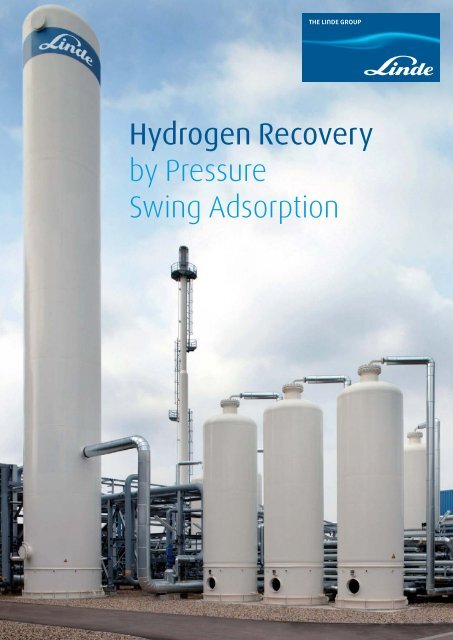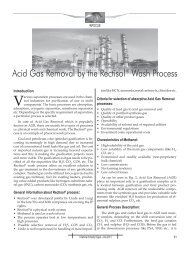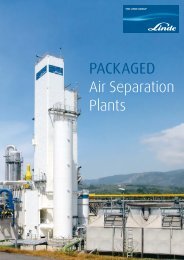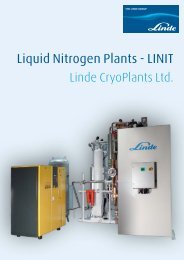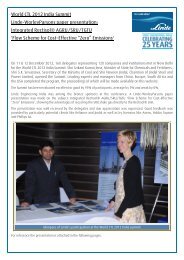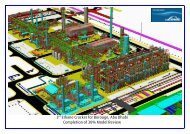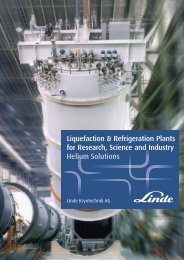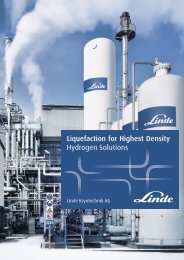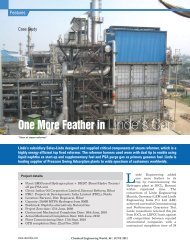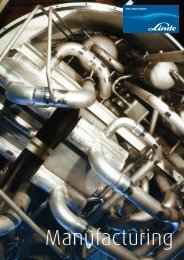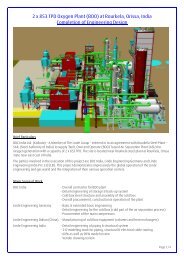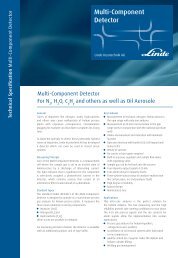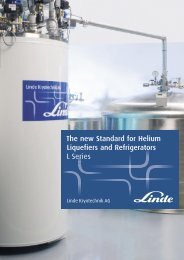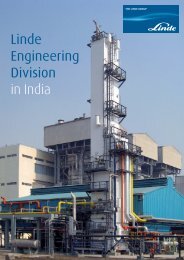Hydrogen Recovery by Pressure Swing Adsorption - Linde-India
Hydrogen Recovery by Pressure Swing Adsorption - Linde-India
Hydrogen Recovery by Pressure Swing Adsorption - Linde-India
You also want an ePaper? Increase the reach of your titles
YUMPU automatically turns print PDFs into web optimized ePapers that Google loves.
<strong>Hydrogen</strong> <strong>Recovery</strong><br />
<strong>by</strong> <strong>Pressure</strong><br />
<strong>Swing</strong> <strong>Adsorption</strong>
2<br />
Contents.<br />
3 Introduction<br />
4 The process<br />
5 The PSA sequence<br />
6 Scope of work<br />
7 The advantages<br />
8 Contact
Introduction.<br />
The experience.<br />
The use of the <strong>Pressure</strong> <strong>Swing</strong> <strong>Adsorption</strong> (PSA) process<br />
has seen tremendous growth during the last decades<br />
mainly due to its simplicity and low operating costs.<br />
Major applications have been the recovery of high purity<br />
hydrogen, methane and carbon dioxide as well as the<br />
generation of nitrogen and oxygen. In addition, it has<br />
gained significance for the bulk removal of carbon<br />
dioxide from direct reduction top-gases.<br />
<strong>Linde</strong> as the world leader in adsorption technology<br />
has designed and supplied more than 500 PSA plants<br />
– including the world‘s largest units and units with<br />
highest availability.<br />
The <strong>Linde</strong> hydrogen PSA units<br />
The well proven <strong>Linde</strong> high performance PSA<br />
units are designed for the recovery and purification<br />
of pure hydrogen from different hydrogen<br />
-rich streams, such as synthesis gases from<br />
steam reforming process, partial oxidation or<br />
gasification, as well as from various off-gases<br />
in refineries or petrochemical processes, e.g.<br />
ethylene off-gas, coke oven gas, methanol and<br />
ammonia purge gas.<br />
Capacities range from a few hundred Nm³/h to<br />
large scale plants with more than 400,000 Nm³/h.<br />
The hydrogen product meets every purity requirement<br />
up to 99.9999 mol-% and is achieved<br />
at highest recovery rates.<br />
Main hydrogen consumers are refineries requiring<br />
this valuable gas for example for their<br />
cracking, dearomatization or desulphurization<br />
processes.<br />
As a second group of users in the petrochemical<br />
industry has a demand for hydrogen for its<br />
methanol and ammonia synthesis, MTBE processes,<br />
etc.<br />
<strong>Linde</strong>‘s PSA systems have proven to be successful<br />
in cases where performance, flexibility, availability<br />
and reliability are the determining factors.<br />
High quality and easy accessibility to all components<br />
minimize and facilitate maintenance to<br />
the maximum extent.<br />
3
4<br />
The process.<br />
Separation <strong>by</strong> adsorption<br />
The <strong>Pressure</strong> <strong>Swing</strong> <strong>Adsorption</strong> (PSA) techno logy<br />
is based on a physical binding of gas molecules<br />
to adsorbent material. The respective force acting<br />
between the gas molecules and the adsorbent<br />
material depends on the gas component,<br />
type of adsorbent material, partial pressure of<br />
the gas component and operating temperature.<br />
A qualitative ranking of the adsorption forces is<br />
shown in the figure below.<br />
The separation effect is based on differences in<br />
binding forces to the adsorbent material. Highly<br />
volatile components with low polarity, such as<br />
hydrogen, are practically non-adsorbable as<br />
opposed to molecules as N 2, CO, CO 2, hydrocarbons<br />
and water vapour. Consequently, these<br />
impurities can be adsorbed from a hydrogencontaining<br />
stream and high purity hydrogen is<br />
recovered.<br />
Qualitative ranking of adsorption forces<br />
<strong>Hydrogen</strong><br />
Oxygen<br />
Argon<br />
Nitrogen<br />
Carbon monoxide<br />
Methane<br />
Carbon dioxide<br />
Ethane<br />
Ethylene<br />
Propane<br />
Butane<br />
Propylene<br />
Ammonia<br />
<strong>Hydrogen</strong> sulfide<br />
Mercaptanes<br />
BTX<br />
Water<br />
<strong>Adsorption</strong> and regeneration<br />
The PSA process works at basically constant<br />
temperature and uses the effect of alternating<br />
pressure and partial pressure to perform adsorption<br />
and desorption. Since heating or cooling is<br />
not required, short cycles within the range of<br />
minutes are achieved. The PSA process consequently<br />
allows the economical removal of large<br />
amounts of impurities.<br />
The figure on page 5 illustrates the pressure<br />
swing adsorption process. It shows the adsorption<br />
isotherms describing the relation between<br />
partial pressure of a component and its equilibrium<br />
loading on the adsorbent material for a<br />
given temperature.<br />
weak<br />
strong<br />
<strong>Adsorption</strong> is carried out at high pressure (and<br />
hence high respective partial pressure) typically<br />
in the range of 10 to 40 bar until the equilibrium<br />
loading is reached. At this point in time, no<br />
further adsorption capacity is available and the<br />
adsorbent material must be regenerated. This<br />
regeneration is done <strong>by</strong> lowering the pressure<br />
to slightly above atmospheric pressure resulting<br />
in a respective decrease in equilibrium loading.<br />
As a result, the impurities on the adsorbent<br />
material are desorbed and the adsorbent material<br />
is regenerated. The amount of impurities removed<br />
from a gas stream within one cycle<br />
corresponds to the difference of adsorption to<br />
desorption loading.<br />
After termination of regeneration, pressure is<br />
increased back to adsorption pressure level and<br />
the process starts again from the beginning.<br />
<strong>Pressure</strong> swing adsorption plant in Leuna, Germany
Differential loading<br />
<strong>Adsorption</strong> loading<br />
Desorption loading<br />
A PSA plant consists basically of the adsorber<br />
vessels containing the adsorbent material, tail<br />
gas drum(s), valve skid(s) with interconnecting<br />
piping, control valves and instrumentation and<br />
a control system for control of the unit.<br />
The pressure swing adsorption process has four<br />
basic process steps:<br />
– <strong>Adsorption</strong><br />
– Depressurization<br />
– Regeneration<br />
– Repressurization<br />
To provide continuous hydrogen supply, minimum<br />
4 adsorber vessels are required. The figure<br />
on page 6 shows the combination of the sequences<br />
of four adsorber vessels as a pressure-timediagram.<br />
<strong>Adsorption</strong><br />
<strong>Adsorption</strong> of impurities is carried out at high<br />
pressure being determined <strong>by</strong> the pressure of<br />
the feed gas. The feed gas flows through the<br />
adsorber vessels in an upward direction. Impurities<br />
such as water, heavy hydrocarbons, light<br />
hydrocarbons, CO 2, CO and nitrogen are selectively<br />
adsorbed on the surface of the adsorbent<br />
P D<br />
Desorption pressure<br />
The PSA sequence.<br />
0°C<br />
30°C<br />
50°C<br />
Partial pressure<br />
material. Highly pure hydrogen exits the adsorber<br />
vessel at top. After a defined time, the adsorption<br />
phase of this vessel stops and regeneration<br />
starts. Another adsorber takes over the<br />
task of adsorption to ensure continuous hydrogen<br />
supply.<br />
Regeneration<br />
The regeneration phase consists of basically<br />
five consecutive steps:<br />
– <strong>Pressure</strong> equalization<br />
– Provide purge<br />
– Dump<br />
– Purging<br />
– Repressurization<br />
200°C<br />
The steps are combined so as to minimize hydrogen<br />
losses and consequently to maximize the<br />
hydrogen recovery rate of the PSA system.<br />
<strong>Pressure</strong> equalization (step E1)<br />
Depressurization starts in the co-current direction<br />
from bottom to top. The hydrogen still stored<br />
in the void space of the adsorbent material is<br />
used to pressurize another adsorber having just<br />
terminated its regeneration. Depending on the<br />
<strong>Adsorption</strong> isotherms<br />
P A<br />
<strong>Adsorption</strong> pressure<br />
<strong>Adsorption</strong> and regeneration <strong>by</strong> pressure swing<br />
total number of adsorbers and the process conditions,<br />
one to four of these so-called pressure<br />
equalization steps are performed. Each additional<br />
pressure equalization step minimizes<br />
hydrogen losses and increases the hydrogen<br />
recovery rate.<br />
Provide purge (step PP)<br />
This is the final depressurization step in co-<br />
current direction providing pure hydrogen to<br />
purge or regenerate another adsorber.<br />
Dump (step D)<br />
At a certain point of time, the remaining pressure<br />
must be released in counter-current direction<br />
to prevent break-through of impurities at<br />
the top of the adsorber. This is the first step of<br />
the regeneration phase when desorbed impurities<br />
leave the adsorber at the bottom and flow<br />
to the tail gas system of the PSA plant.<br />
5
6<br />
Purging (regeneration)<br />
Final desorption and regeneration is performed<br />
at the lowest pressure of the PSA sequence.<br />
Highly pure hydrogen obtained from an adsorber<br />
in the provide purge step, is used to purge the<br />
desorbed impurities into the tail gas system.<br />
The residual loading on the adsorbent material is<br />
reduced to a minimum to achieve high efficiency<br />
of the PSA cycle.<br />
Repressurization (steps R1/R0)<br />
Before restarting adsorption, the regenerated<br />
adsorber must be pressurized again. This is<br />
accomplished in the pressure equalization step<br />
<strong>by</strong> using pure hydrogen from adsorbers presently<br />
under depressurization. Since final adsorption<br />
pressure cannot be reached with pressure<br />
equalization steps, repressurization to adsorption<br />
pressure is carried out with a split stream<br />
from the hydrogen product line.<br />
Having reached the required pressure level<br />
again, this regenerated adsorber takes over the<br />
task of adsorption from another vessel having<br />
just terminated its adsorption phase.<br />
<strong>Pressure</strong><br />
Adsorber A<br />
Adsorber B<br />
Adsorber C<br />
D<br />
R1<br />
Adsorber D<br />
E1<br />
<strong>Adsorption</strong><br />
R0<br />
Regeneration<br />
PP<br />
E1<br />
R1<br />
D<br />
Scope of work.<br />
The typical scope of supply<br />
of <strong>Linde</strong>‘s PSA units includes:<br />
– Prefabricated valve skid<br />
– Adsorber vessels<br />
– Specially selected adsorbent material<br />
– Tail gas drum<br />
– Process control system<br />
The scope can be altered to best suit client‘s<br />
needs. Based on the customer‘s requirements,<br />
feed gas compressor or tail gas compressor<br />
systems can be offered through <strong>Linde</strong> as a<br />
integrated PSA solution.<br />
PP<br />
<strong>Adsorption</strong><br />
R0<br />
D<br />
E1<br />
Regeneration R1<br />
Regeneration<br />
<strong>Adsorption</strong><br />
R0<br />
PP<br />
D<br />
R1<br />
E1<br />
<strong>Adsorption</strong><br />
<strong>Pressure</strong> time diagram<br />
R0<br />
Regeneration<br />
PP<br />
PSA valve skid<br />
Time
The advantages.<br />
The <strong>Linde</strong> high performance PSA units provide<br />
remarkable advantages such as:<br />
<strong>Linde</strong>‘s expertise in adsorption technology<br />
Based on customer‘s requirements, the <strong>Linde</strong><br />
PSA specialists will select the optimum PSA<br />
system for the specific purification task in terms<br />
of optimum ratio between plant performance<br />
and investment cost.<br />
Quality<br />
The high switching cycles of PSA units require<br />
special equipment distinguished <strong>by</strong> a high degree<br />
of durability. <strong>Linde</strong> only applies qualified<br />
components, which meet these demands perfectly<br />
and which are proven during many years<br />
of experience.<br />
Reliability<br />
The use of selected and suitable components<br />
implies the high reliability of <strong>Linde</strong>‘s PSA systems.<br />
Especially high performance switching<br />
valves are used in <strong>Linde</strong>‘s PSA process.<br />
Availability<br />
The <strong>Linde</strong> PSA systems are characterized <strong>by</strong> an<br />
outstanding availability of hydrogen supply.<br />
With its special features such as operation with<br />
reduced number of adsorbers, adsorber group<br />
isolation and redundant control system, <strong>Linde</strong>‘s<br />
PSA units achieve virtually 100% on-stream<br />
performance and availability.<br />
Flexibility<br />
Excellent flexibility to match actual client‘s<br />
needs are achieved with <strong>Linde</strong>‘s PSA systems<br />
as they are capable of providing a high degree<br />
of flexibility to cope with feed gas conditions<br />
and varying hydrogen demand.<br />
Two pressure swing adsorption units in Canada<br />
Modular design and prefabricated equipment<br />
<strong>Linde</strong>‘s high performance PSA systems are prefabricated<br />
to a maximum extent. The valve skids<br />
containing switching and control valves, instrumentation<br />
and interconnecting piping are completely<br />
prefabricated, preassembled and tested<br />
prior to delivery. This design philosophy reduces<br />
time and costs for erection and commissioning<br />
on site to and absolute minimum.<br />
Easy maintenance<br />
Maintenance is limited to easy and quick routine<br />
actions which can be carried out <strong>by</strong> the<br />
operators on site. Highest attention is given to<br />
a proper accessibility of all valves and instruments<br />
inside the valve skid. Assistance from<br />
<strong>Linde</strong> is hence normally not required but is<br />
certainly available at any time convenient to<br />
client.<br />
7
Designing Processes - Constructing Plants.<br />
<strong>Linde</strong>´s Engineering Division continuously develops extensive process engineering know-how in the planning,<br />
project management and construction of turnkey industrial plants.<br />
The range of products comprises:<br />
− Petrochemical plants<br />
− LNG and natural gas processing plants<br />
− Synthesis gas plants<br />
− <strong>Hydrogen</strong> plants<br />
− Gas processing plants<br />
− <strong>Adsorption</strong> plants<br />
− Air separation plants<br />
− Cryogenic plants<br />
− Biotechnological plants<br />
− Furnaces for petrochemical plants and refineries<br />
Engineering Division head office:<br />
Engineering Division headquarters:<br />
<strong>Linde</strong> AG<br />
Engineering Division, Dr.-Carl-von-<strong>Linde</strong>-Str. 6-14, 82049 Pullach, Germany<br />
Phone +49.89.7445-0, Fax +49.89.7445-4908, E-Mail: info@linde-le.com, www.linde.com<br />
<strong>Linde</strong> and its subsidiaries manufacture:<br />
− Packaged units, cold boxes<br />
− Coil-wound heat exchangers<br />
− Plate-fin heat exchangers<br />
− Cryogenic standard tanks<br />
− Air heated vaporizers<br />
− Spiral-welded aluminium pipes<br />
More than 3,800 plants worldwide document the leading position of the Engineering Division in international plant construction.<br />
<strong>Linde</strong> AG<br />
Engineering Division<br />
Pullach, Germany<br />
Phone: +49.(0)89.7445-0<br />
Engineering Division Fax: +49.(0)89.7445-4908 <strong>Linde</strong> Impianti Italia S.p.A.<br />
Schalchen Plant info@linde-le.com<br />
Tacherting, Germany<br />
Rome, Italy<br />
Phone +39.066.5613-1<br />
Phone +49.8621.85-0<br />
Fax +39.066.5613-200<br />
Fax +49.8621.85-6620<br />
r.tikovsky@lindeimpianti.it<br />
plantcomponents@linde-le.com<br />
<strong>Linde</strong>-KCA-Dresden GmbH<br />
<strong>Linde</strong> Kryotechnik AG<br />
Pfungen, Switzerland<br />
Dresden, Germany<br />
Phone +41.52.3040-555<br />
Phone +49.351.250-30<br />
Fax +41.52.3040-550<br />
Fax +49.351.250-4800<br />
info@linde-kryotechnik.ch<br />
lkca.dresden@linde-kca.com<br />
Selas-<strong>Linde</strong> GmbH<br />
Cryo AB<br />
Göteborg, Sweden<br />
Pullach, Germany<br />
Phone +46.3164-6800<br />
Phone +49.89.7447-470<br />
Fax +46.3164-2220<br />
Fax +49.89.7447-4717<br />
gunnar.lenneras@cryo.aga.com<br />
selas-linde@linde-le.com<br />
Cryostar SAS<br />
<strong>Linde</strong> Process Plants, Inc.<br />
Tulsa, OK, U.S.A.<br />
Hésingue, France<br />
Phone +1.918.4771-200<br />
Phone +33.389.70-2727<br />
Fax +1.918.4771-100<br />
Fax +33.389.70-2777<br />
sales@lppusa.com<br />
info@cryostar.com<br />
<strong>Linde</strong> CryoPlants Ltd.<br />
Selas Fluid Processing Corp.<br />
Blue Bell, PA, U.S.A.<br />
Aldershot, Great Britain<br />
Phone +1.610.834-0300<br />
Phone +44.1.252.3313-51<br />
Fax +1.610.834-0473<br />
Fax +44.1.252.3430-62<br />
john.mcdermott@selasfluid.com<br />
info@linde-lcl.com<br />
<strong>Linde</strong> Engenharia do Brasil Ltda.<br />
Rio de Janeiro, Brazil<br />
Phone +55.21.3545-2255<br />
Fax +55.21.3545-2257<br />
jaime.basurto@linde.com<br />
<strong>Linde</strong> Process Plants (Pty.) Ltd.<br />
Johannesburg, South Africa<br />
Phone +27.11.490-0513<br />
Fax +27.11.490-0412<br />
lindepp@global.co.za<br />
<strong>Linde</strong>-KCA Russia Branch<br />
Moscow, Russia<br />
Phone +7.495.646-5242<br />
Fax +7.795.646-5243<br />
dirk.westphal@linde-kca.com<br />
<strong>Linde</strong> Arabian Contracting Co. Ltd.<br />
Riyadh, Kingdom of Saudi Arabia<br />
Phone +966.1.419-1193<br />
Fax +966.1.419-1384<br />
linde-ksa@linde-le.com<br />
<strong>Linde</strong> Engineering Middle East LLC<br />
Abu Dhabi, United Arab Emirates<br />
Phone +971.2.4477-631<br />
Fax +971.2.4475-953<br />
linde@emirates.net.ae<br />
<strong>Linde</strong> Engineering <strong>India</strong> Pvt. Ltd.<br />
Vadodara, Gujarat, <strong>India</strong><br />
Phone +91.265.3056-789<br />
Fax +91.265.2335-213<br />
sales@linde-le.com<br />
<strong>Linde</strong> Engineerig Far East, Ltd.<br />
Seoul, South Korea<br />
Phone +82.2789-6697<br />
Fax +82.2789-6698<br />
hanyong.lee@linde.com<br />
<strong>Linde</strong> Engineering Division<br />
Bangkok, Thailand<br />
Phone +66.2636-1998<br />
Fax +66.2636-1999<br />
anuwat.krongkrachang@linde.com<br />
<strong>Linde</strong> Engineering Co. Ltd.<br />
Dalian, P.R. of China<br />
Phone +86.411.39538-800<br />
Fax +86.411.39538-855<br />
jochen.nippel@lindeleh.com<br />
<strong>Linde</strong> Engineering Co. Ltd.<br />
Hangzhou, P.R. of China<br />
Phone +86.571.87858-222<br />
Fax +86.571.87858-200<br />
hangzhou.leh@lindeleh.com<br />
<strong>Linde</strong> Engineering Division<br />
Beijing Representative Office<br />
Beijing, P.R. of China<br />
Phone +86.10.6437-7014<br />
Fax +86.10.6437-6718<br />
linde@public.bta.net.cn<br />
<strong>Linde</strong> AG Taiwan Branch<br />
Engineering Division<br />
Taipei, Taiwan<br />
Phone +886.2.2786-3131<br />
Fax +886.2.2652-5871<br />
bernhard.puerzer@linde-le.com<br />
<strong>Linde</strong> Australia Pty. Ltd.<br />
Chatswood N.S.W., Australia<br />
Phone +61.29411-4111<br />
Fax +61.29411-1470<br />
willy.dietrich@linde.com.au<br />
HA/H 1.1.e/09


